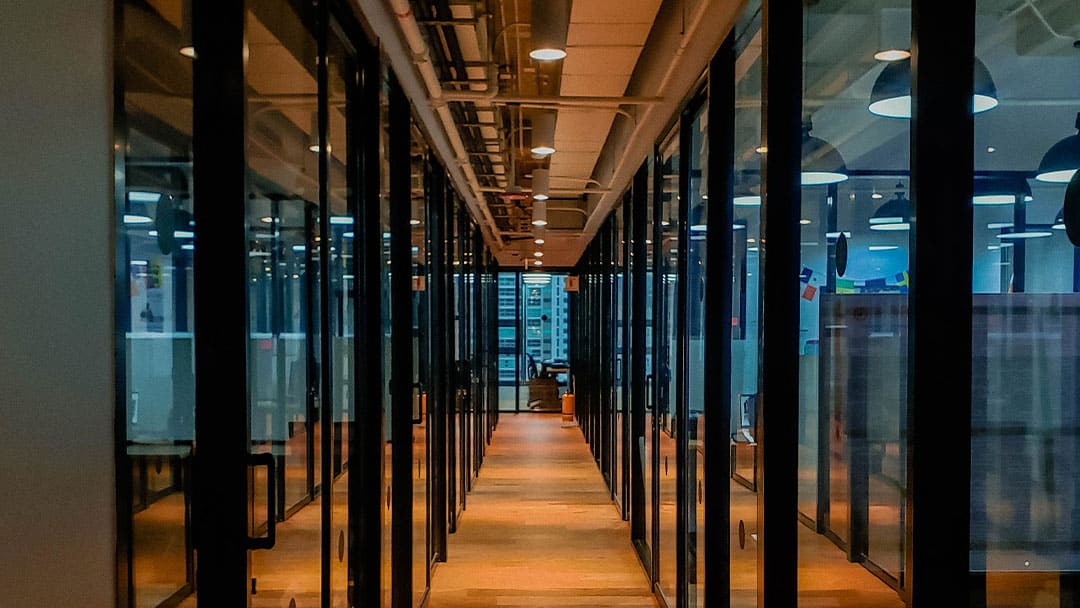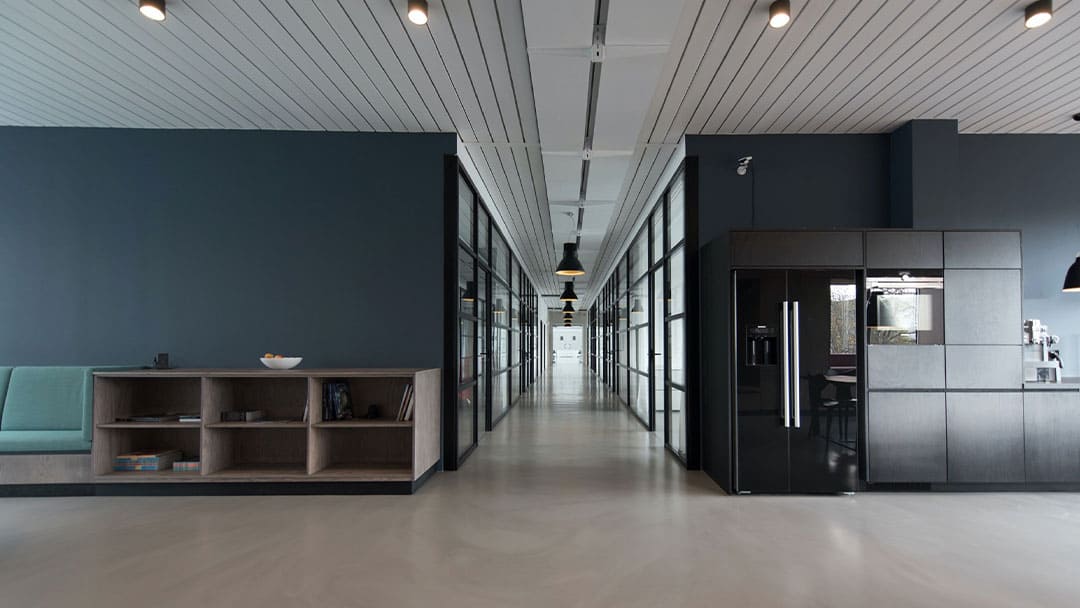Power over Ethernet (PoE) lighting systems are controlled through the IT network. It is a relatively new technology, but it is growing at an astounding rate. The push to build more sustainable buildings, reduce our carbon footprint, and be good stewards of the planet that we live on is driving fast-paced growth in green building technologies.
PoE lighting is expected to reach a 922 million dollar industry by 2026. The booming commercial and industrial sectors are adopting PoE lighting quickly, leading to a projected 30% growth over the next five years. Government initiatives incentivize the trend towards greener buildings, while consumer demand and societal pressures offer an additional nudge. And we are guessing that the excellent PR that goes along with it doesn’t hurt business either!
What is Power over Ethernet (PoE) Lighting
PoE lighting or power over ethernet lighting is a form of smart lighting for buildings. These systems drastically improve the control of the lighting of a room while lowering power bills and exponentially increasing the length of the life of light bulbs. PoE technology can be controlled through smartphone apps which adds the convenience of remote applications.
PoE lighting systems use the power of ethernet cables to power the fixtures and the lights, or luminaires, and transmit data from the light fixtures to the control software. Using this data, the system uses motion sensors to determine the people in the room and, when the space is not in use, shutting the lights off to conserve energy. The space utilization data is invaluable to the facilities management and corporate real estate teams.
Related: Here are the Top 5 Reasons Enterprises are Adopting SD-WAN
Why use PoE Lighting?
Smart PoE platform controls allow customers to manage their lighting needs as part of a more extensive building system because both the power supply and data are broadcast through the same cable. It feels a little futuristic, but the technology capabilities now allow us to integrate multiple building systems into a central command unit using data. Lighting, air temperature, and building security are just some of the ways that smart buildings are using technology to balance creature comforts with measurable energy savings.
Power over Ethernet and Smart Building Automation
Light-emitting diode (LED) technology is digital. LED lights provide the perfect platform to bridge technology and utility. Connected lighting systems use PoE technology to connect lighting fixtures to building automation features.
PoE lighting systems send low-voltage power over ethernet cables. That power operates the luminaires to light a room. Smart lighting systems are cost-effective to install, provide flexibility, over-improving occupant comfort, and contribute to energy-efficient utility usage.
Lights can do more than just turn on and turn off. Smart lights connected to a computerized system can change colors and dim to balance natural light and create optimal working environments to boost employees’ productivity and maximize the comfort of visitors. And at the same time, these smart lights provide invaluable feedback data that powers AI processes, allowing buildings to adjust energy consumption based on occupancy patterns.
C&C Technology Group provides physical infrastructure systems that support PoE smart building technology. Our systems are designed for connectivity and scalability to serve your needs now and in the future. Learn more about our technology today!

Related: Network & Cable Testers Buyers Guide
Who are the Innovators in PoE Lighting?
Big names are emerging in the PoE industry. Each company offers a slightly different solution. Let’s talk about the pros and cons of each and the best applications for each. C&C Technology Group has been supporting the foundational infrastructure for these systems for the last 38 years. Creating sustainable, scalable solutions that will grow with your building and technology needs requires choosing the right partners.
#1 – Inspextor by MHT Technologies
Founded in 2008, MHT Technologies is an industry leading New York-based PoE building automation software company and lighting manufacturer. MHT’s offerings include their flagship product, Inspextor, an end-to-end PoE-based solution including the hardware and software necessary to create a smart building. Inspextor’s hardware powers, manages, and integrates systems such as lighting, shades, sensors, access controls, and security devices. The Inspextor software provides actionable consumption data that building owners and managers can use to set energy efficiency policies and controls – all within one dashboard.
Inspextor leads the market with features such as a specialized sustainability dashboard for reporting and ESG goals, AI capabilities, an intuitive graphic user interface (GUI), and the highest encryption security available on the market today. This gives Inspextor clients an unprecedented level of data insights, space personalization, and enhanced control of their environment.
#2 – NuLEDs by Mecho
NuLEDs are, exactly as the name implies, a new technology to power LED light fixtures designed specifically for PoE systems. These lights use low-voltage power using a CAT5e cable, which is expected to become standard in newer buildings. NuLED was recently acquired by Mecho, a globally positioned commercial shading company, in an effort to gain position in this budding market.
As one of the first to market, NuLEDs began outfitting Cisco labs and demo areas during its first year and then began supplying PoE lighting systems to customers such as Independence Blue Cross, Miami Dade School District, and Dart Container. NuLEDs had their first Higher Education installation at University of Glasgow, then continued with PoE lighting installations in London and Dubai.
NuLEDs was also selected from many fierce competitors to provide the PoE lighting in all the Cisco Corporate Executive Suites in Silicon Valley.
#3 – Platformatics
Platformatics offers a fully integrated, cloud-based PoE system. The system includes PoE nodes, light fixtures, sensors, wall switches, ethernet switches, area controllers, and cloud-based connectivity. Platformatics systems make it easy to integrate power and control with existing IT systems. With recent acquisition by light fixture manufacturer H.E. Williams, their technology and partner ecosystem has suffered. Most will be avoiding this system in the future.
Related: What is Fiber Optics and How Does It Works?
#4 – Genisys
Genisys is a division of innovative lighting in Des Moines, IA. They focus on PoE solutions, hold multiple patents, and have been widely recognized as an industry leader. Genisys offers a wide range of PoE hardware that can be used to build larger systems. However, they don’t bill themselves as a complete solution like competitors do.
#5 – Smartengine by wtec
Smartengine is a network-powered smart building technology that provides lighting control, efficiency, and a fine mesh sensor network throughout the built space. Since its first commercial deployment in 2010, this technology has gained global recognition, being deployed in over 25 countries and trusted by 20+ Fortune 100 and Blue Chip Companies.
The fine mesh sensor network provided by the wtec technology provides many data points for the building or its users in real-time. smartsensors collect temperature, motion, light level, energy consumption and can generate and detect beacons in the iBeacon format. At the same time, smart wall controllers have integrated IAQ sensors that collect temperature, humidity, air pressure, IAQ, relative VOC, and relative CO2.
Smartengine’s centralized power and control of light fixtures distinguishes it from traditional PoE systems that rely on fixture-level nodes. To be more specific, it isn’t PoE at all but rather a proprietary technology. This approach works well for some applications and poorly for others.
#6 – Igor
Igor’s proprietary platform Nexos is built for automation and data mining to bring smart building technology full circle. Igor offers a simple platform that uses IoT infrastructure to provide reliability, scalability, and security for robust smart building technologies. This type of technology lets buildings leverage the power of green building performance to boost productivity, increase comfort, and reduce costs. In the past year Igor has scaled back it market development efforts. Growing pains as a start up are challenging.
#7 – Molex
The CoreSync platform by Molex offers one of the more widely used systems that is available on the market today, however it has numerous system flaws that are widely acknowledged by designers and integrators. While many clients may have chosen Molex because of the security perceived by the company’s size – Afterall, Molex is arguably the largest in the space – Size means little if it doesn’t actually work. Couple that with Mecho entering the industry by the acquisition of NuLEDs, there is little reason to consider Molex.
Our Pick
While the landscape in the PoE building automation space is ever changing, it is safe to place your confidence in MHT Technologies. As a foundational smart building technology platform they have just the right mix of technical advancement, financial size /stability and flexibility needed to execute a successful IoT building automation project.

3 Reasons Why POE Lighting is a Must for a Hybrid Work Environment
PoE lighting reduces power, material, labor, and maintenance
PoE lighting decreases the upfront expenses and shortens the time frame for the completion of wiring, setup, and arrangement. This also includes a significant decrease in the installation “carbon footprint” – no conduit necessary, no high voltage copper wiring required
The utilization of low-voltage PoE enhances safety and removes the need for a licensed electrician for installation and any potential modifications.
Since LED lights require DC power to function, LED fixtures powered by AC must convert their power source through a transformer to DC, leading to a 20% loss of power in the form of heat. With PoE being native DC power, no transformer is required, and thus no energy loss.
PoE lighting allows security and flexibility in design
“DC-powered LEDs consume less energy and hence run cooler, allowing for a compact design as no AC-to-DC conversion or transformer is necessary. With the added advantage of no reflectors or diffusers, PoE lighting can be installed in previously inaccessible areas.
Having the freedom from high voltage AC power sources, indoor light fixtures can be placed exactly where they’re needed and easily relocated if required.
The wired connection of PoE lighting eliminates the potential interference associated with wireless lighting control systems while providing enhanced security options like macro and micro-segmentation.
PoE lighting is easily paired with sensors, shades, and HVAC controllers
By leveraging the versatile 90W PoE technology to both power and secure the building’s network, you can interconnect shades, sensors, HVAC controllers, tags, and cameras to monitor temperature, light, humidity, VOCs, occupancy, and density. This helps optimize lighting and air quality, making the workspace more sustainable, healthy, and comfortable.
For building owners and managers, automating lighting and creating personalized environments appeals to tenants and boosts revenue per square foot. Real-time energy tracking on a fixture-by-fixture, room-by-room, floor-by-floor, or building-by-building basis quantifies energy consumption, enables scheduled energy-saving modes, enhances tenant satisfaction, and reduces the carbon footprint while saving money.
For building users, it offers personal control over lighting and the ability to optimize it based on their circadian rhythm. By programming room lighting to change color temperature and reduce eye strain from blue light in the evenings, it mimics natural light indoors and enhances comfort.
The Bottom Line on Power over Ethernet Lighting
Lighting is just one system in a building. But it can significantly impact energy consumption, especially when empty offices and conference rooms stay lit well after occupants have left the space. Several companies are leveraging IoT infrastructure to revolutionize lighting. The systems do more than use timers or sensors. They can adjust light intensity, light color, collect data, and establish building occupant patterns for more innovative controls.
C&C Technology Group is invested in providing solutions for data centers, smart buildings, and hybrid workplaces that leverage the power of the digital world to create smart infrastructure for scalable systems. Learn more about our services today!
Last Updated on May 12, 2023 by Josh Mahan




